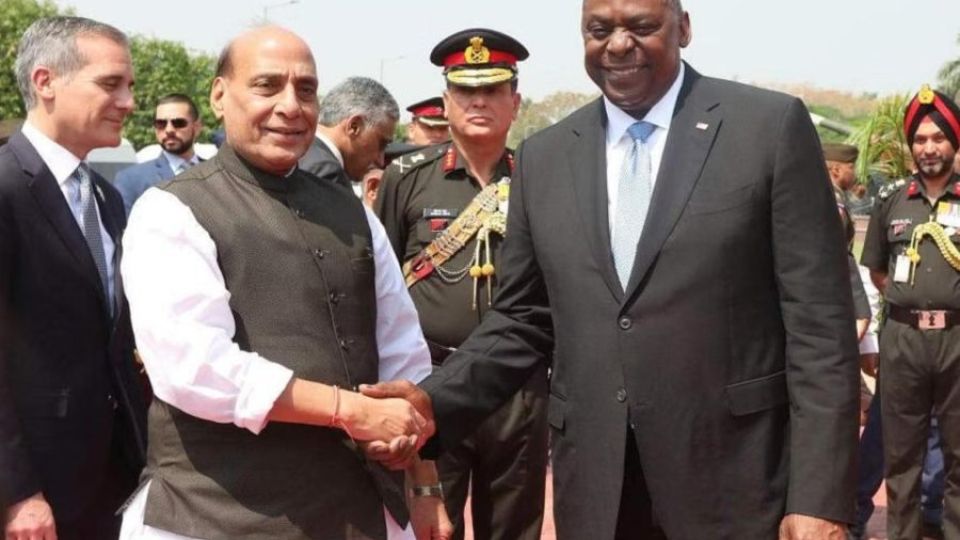June 6, 2023
KOLKATA – India and the United States have agreed on a road map to further strengthen their defence industrial partnership, including by fast-tracking cooperation and co-production in areas such as air combat and land mobility systems, reconnaissance, munitions and the undersea domain.
This was announced by the US Department of Defence (DOD) on Monday following a bilateral meeting between India’s Defence Minister Rajnath Singh and his American counterpart, Defence Secretary Lloyd Austin, who was in New Delhi on a two-day visit.
According to an Indian government statement, the US-India Defence Industrial Cooperation road map will guide both countries in the “next few years” as they explore ways to build resilient supply chains and facilitate increased collaboration between the Indian and American defence start-up ecosystems.
The bilateral meeting comes amid China’s aggressive posturing in the Indo-Pacific region, an issue which featured at the recent Shangri-La Dialogue in Singapore, as well as in the discussions in New Delhi.
Speaking at the dialogue, Mr Austin said the US was “doubling down on our alliances and our partnerships” in the Indo-Pacific to “deter aggression and to deepen the rules and norms that promote prosperity and prevent conflict”.
Echoing these thoughts, Mr Singh said on Twitter on Monday that the India-US partnership is “critical for ensuring a free, open and rules-bound Indo-Pacific region”.
According to the DOD release, Mr Austin and Mr Singh committed to strengthening operational collaboration across all military services, “with an eye to supporting India’s leading role as a security provider in the Indo-Pacific”.
The meeting also comes ahead of Prime Minister Narendra Modi’s state visit to the US from June 21 to 24, and featured some key deliverables expected to be announced during this trip.
These include the India-US Defence Acceleration Ecosystem, a new initiative to advance cutting-edge technology cooperation that will be launched by the US-India Business Council on June 21.
Another deal that did not figure in official statements but was reportedly discussed is one that would permit General Electric to manufacture jet engines for Indian military aircraft in India.
The US is the third-largest arms supplier to India, the world’s largest arms importer, accounting for 11 per cent of total global imports from 2018 to 2022, according to the Stockholm International Peace Research Institute. It is preceded by Russia and France, who were India’s top two suppliers during this period.
Since 2002, India and the US have intensified their military ties by signing a series of strategic agreements. These include four key deals – Basic Exchange and Cooperation Agreement (signed in 2020), Communications Compatibility and Security Agreement (2018), Logistics Exchange Memorandum of Agreement (2016), and the General Security of Military Information Agreement (2002).
With the conclusion of these four “foundational agreements”, India had “met requirements to become part of America’s integrated deterrence network”, said Mr Pravin Sawhney, editor of monthly defence magazine Force.
“What the US is looking at now is basically how to strengthen India’s military capabilities and slowly get India to do advanced exercises as part of the US deterrence network against China,” he told The Straits Times.
Beyond the jet engine and other defence deals, Mr Sawhney said the long-term focus of Mr Austin’s visit was on deepening collaboration with India on critical and emerging technologies.
The two countries launched an India-US Initiative on Critical and Emerging Technologies (iCET) in May 2022, and followed up in January with the first iCET meeting where they signed a new partnership arrangement between the US National Science Foundation and Indian science agencies to expand collaboration in areas such as artificial intelligence (AI), quantum and advanced wireless technologies.
Promoting collaboration on high-performance computing and “trustworthy AI” and launching a new “Innovation Bridge” that will connect US and Indian defence start-ups were also agreed upon.
“This is a very big offer, considering that India is just about starting in these areas and the Americans are quite advanced in them,” Mr Sawhney added.
Dr Harsh V. Pant, vice-president for studies and foreign policy at Observer Research Foundation, a Delhi-based think-tank, said the India-US bilateral relationship has continued to grow despite challenges such as the war in Ukraine, a crisis that has seen India refrain from directly criticising Russia – another of its strategic partners.
“It has been a positive story for US-India ties and defence is becoming a very important component in this relationship,” he said.
But he noted that a key challenge would be to reconcile differences over US intellectual property requirements with India’s push towards co-production and sharing of technology. “I think this is the most important challenge that the two nations face at the moment,” Dr Pant added.


